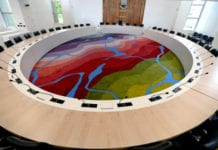Researchers from NUI Galway’s Ryan Institute have published the first ever recorded instance of a False Widow spider feeding on Ireland’s only native lizard species.
The False Widow spider has only recently come to Ireland to Ireland from the UK, but has colonised much of the country since first being reported in 1998.
While it’s not uncommon for spiders to feed on birds and small lizards in tropical parts of the world, up until now no-one has ever reported seeing one feed on Ireland’s native Viviparous lizard.
The gruesome scene was reported in the back garden of a house in Kiliney, Co. Dublin in May 2017, where a juvenile lizard was seen entangled in a web with a False Widow spider eating it’s flesh.
Dr. Michel Durgon from the Venom Systems Laboratory in the Ryan Institute said this raises concerns about the impact False Widows will have on Irish ecosystems.
“The Viviparous lizard is a protected species in Ireland while the Noble False Widow is a recent alien species that is still actively colonising Ireland.”
“This poses the question of the delayed impact of overlooked invasive species on iconic native organisms. It also raises the question of the true impact of the Noble False Widow on our native ecosystems.”
A report on the strange incident has just been published in the Proceedings of the Royal Irish Academy journal.
Noble False Widow Spiders are an adaptable breed that possess a fast acting neurotoxin in their venom that causes paralysis in their prey.
They’ve been attracting more notice in recent years as they become a more common sight in Irish homes.
And while their venom isn’t believed to life-threatening to humans, a bite can cause significant pain and discomfort for several days.
Lead author of the report John Dunbar, a PhD researcher at the Venon Systems Laboratory said this is a rare thing to see, “There are only two previous accounts from other species of False Widow spiders preying on a lizard in Iran and on a snake in Bulgaria.”
Surprisingly, this is the first time the False Widow spider that is currently colonising Ireland has been documented preying on vertebrates.”
Mr. Dunbar said the invading spider has a leg or two up on other spiders its competing with, “In addition to its venom possessing a powerful vertebrate specific neurotoxin, it can produce very strong silk which gives it a real advantage over our native spiders in entangling large prey.”
The Noble False Widow is have detrimental effect on other, native spider species due to their competitiveness and longevity.
Most local spider and bug species in Ireland only live for a year at most, whereas False Widows can live for up to seven years.
This gives the population much more of a chance to explode in numbers.
False Widows are also known to live closer to populated areas, posing a larger threat to wildlife that does the same.
“We are right in the middle of the lizard birthing season and this is when most lizard sightings are made and when juveniles are likely to turn up in gardens,” said co-authors of the report Collie Ennis and Rob Gandola from the Herpetological Society of Ireland.
“Female lizards give birth to between 6-11 babies that are jet black and about 40mm long. It’s the juveniles that disperse to new areas but given their tiny size you can see how this is a dangerous endeavour.”
“We’d ask people who are lucky enough to have lizards near or on their property to keep a watch out and report any sightings of Noble False Widows predating on lizards.”
They said that any information people can provide would be helpful in understanding just how much of an impact False Widows are having on native wildlife.
Dublin, Cork, and Wexford have seen the highest numbers of False Widows to date, but they are expected to continue to spread throughout the country.
Sightings of False Widows can be reported to michel.dugon@nuigalway.ie or by calling 091 494491.












